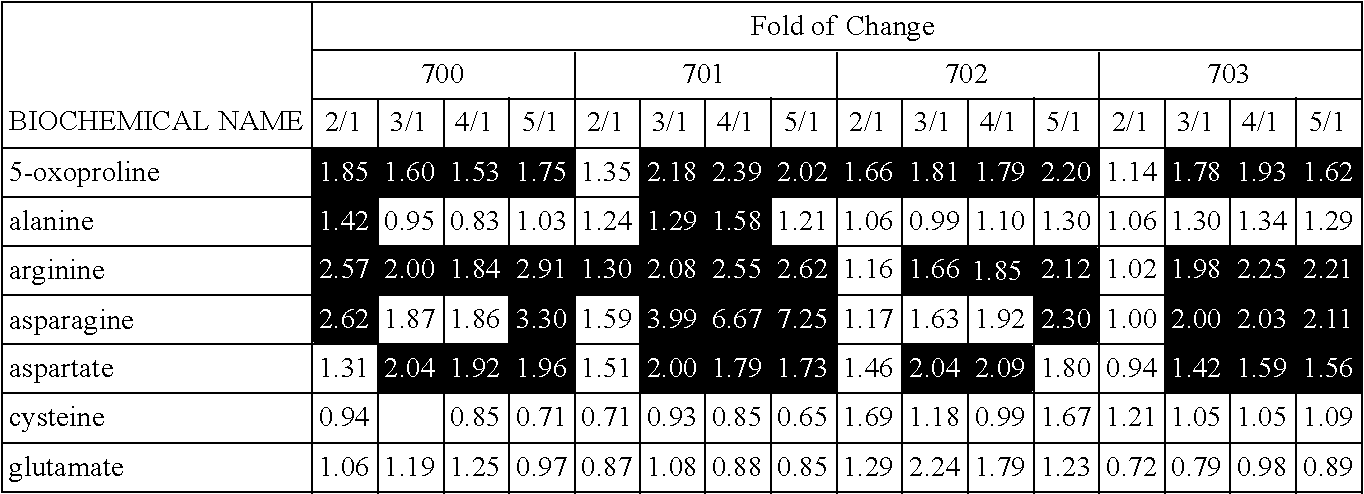Methods of predicting crop yield using metabolic profiling
a metabolic profiling and crop yield technology, applied in the field of plant breeding or genetic engineering, can solve the problems of reducing yield, senescence of leaves, and a drop in photosynthetic capacity, and achieve the effect of efficient crop management practices
- Summary
- Abstract
- Description
- Claims
- Application Information
AI Technical Summary
Benefits of technology
Problems solved by technology
Method used
Image
Examples
example 1
[0190]Four maize lines (A. B, C, and D) were selected for the study based upon the lack of close genetic relation to each other and because they had shown varied nitrogen use efficiencies in a previous year of testing. The field study was machine planted. A complete factorial in a randomized complete block design with four replications was used in which hybrid and N rate were the treatment factors. Each plot consisted of four rows, 17.5 feet in length and spaced 2.5 feet apart. A soil-applied insecticide (tefluthrin) was applied in furrow at a rate of 0.099 lb a.i. acre−1. Weed control consisted of a pre-emergence application of Lumax (S-metolachlor+atrazine+mesotrione) at the labeled rate. N was applied as ammonium sulfate ((NH4)2SO4) in a diffuse band after emergence and incorporated between V2 and V3. The N treatments were applied to between and on either side of the middle two rows of each four row plot. The N rates were 0, 50, 100, 150, and 200 lbs N per ac...
example 2
First Metabolic Profiling Study
[0193]Samples from Example 1 were ground to a fine powder in a modified shredder under dry ice conditions and then sent for metabolite profiling and statistical analysis. Each sample was then analyzed for 267 metabolites using methods essentially as described in Anal. Chem., 2009, 81 (16), pp 6656-6667; and herein incorporated by reference. For visualization of biochemical differences between the various treatment groups, the data are displayed in line plot format. From this analysis, several metabolites profiled in corn un-pollinated ear shoots were shown to positively correlate with yield. The metabolite glutamine measured from unpollinated ear shoots showed a high correlation to yield (approximately 0.89). Likewise, 5-oxoproline, aspartate, arginine and proline metabolite levels measured in unpollinated ear shoots also correlated to grain yield (>0.80). The table below shows the metabolites with the highest positive correlation to yield prediction.
[...
example 3
Re-Analysis of Metabolic Data
[0201]Data Normalization and Preprocessing:
[0202]Raw and imputed data generated in Example 2 was reanalyzed using different methods. The raw data consisted of measurements of all of the metabolites identified in the study by various chromatographic methods. The imputed data is the raw data that has been median normalized where missing values are imputed using the lowest value of a given metabolite. Either raw or imputed data was loaded into SimcaP+12™ software from Umetrics™. All of the metabolite values for the various samples were entered as “X” variables and yield and NUE data were designated “Y” variables. There were a total of 1861 (8.5%) missing values in the raw data for this study. There were no missing data points with the imputed data.
[0203]Data Analysis
[0204]Principal component analysis was performed on the raw, non-imputed data to determine the greatest sources of variance. A total of 10 significant components were detected in the data. A plo...
PUM
| Property | Measurement | Unit |
|---|---|---|
| temperature | aaaaa | aaaaa |
| temperature | aaaaa | aaaaa |
| pH | aaaaa | aaaaa |
Abstract
Description
Claims
Application Information
 Login to View More
Login to View More - R&D
- Intellectual Property
- Life Sciences
- Materials
- Tech Scout
- Unparalleled Data Quality
- Higher Quality Content
- 60% Fewer Hallucinations
Browse by: Latest US Patents, China's latest patents, Technical Efficacy Thesaurus, Application Domain, Technology Topic, Popular Technical Reports.
© 2025 PatSnap. All rights reserved.Legal|Privacy policy|Modern Slavery Act Transparency Statement|Sitemap|About US| Contact US: help@patsnap.com



